Grenada – 2015
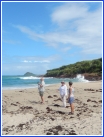
Navigating this
Diary:
The Fearful Father
Is a father allowed to worry about his grown children? Heck, in 2015 my oldest turns fifty, and my youngest turns thirty-seven. When I was thirty-seven, she was my newest baby and I already had three others. When I was fifty I was on tiptoe of becoming one of the senior clergy of my diocese. I knew what I was doing at those august ages, so shouldn’t they?
And of course they gently remind me, “Dad, I’m not a kid, y’know.”
But I still fret.
Near the end of our second week in Grenada, Rachael and her husband Michael, came for a visit.
Rachael, as you probably know, is a flight attendant. Because of her airline’s staff privileges, she and her husband can travel at minimal expense. If no paying customer has bought a seat on a particular aircraft, they can have it. So, in this first year of their marriage, they have been to Italy, and to France, and to Hawaii, and to Winnipeg. And now, during our delightful stay at De White House, they have come to Grenada.
Just for the weekend!
As you may also know, those two are still in their first year of marriage, and in all these travels they resemble honeymooners in the first flush of love. Not only do they see the sights and try the restaurants, they have adventures together. A high place? Let’s climb it! A waterfall? Let’s dive into the pool! White water rafting? Where do we sign? Long hikes in spectacular scenery are meat and potatoes to them.
Long before they arrived, they talked about finding a forest trail in Grenada that they could follow. I mentioned this to Morris Pompey, my host, and he said, “Oh dear, I do hope they engage a guide! Those inland trails are very steep and treacherous, and it is easy to lose your way!”
But when Rachael and Michael got off the plane, they were quite determined to do it without a guide. Apparently Michael – who is extremely adept with technology – has an “App” on his smartphone that has the coordinates and maps of exotic trails all over the world. Using the phone’s GPS system, the app evidently shows you exactly where you are on one of those trails. What a GPS device does for a car, this app does for a hiker.
He had located a five kilometre hike that begins at a crater lake in Grenada’s Grand Etang National Park, goes up the crater wall, then down to a small river. It follows the river to a spectacular waterfall, where it ends, at the base of the waterfall, among some tourist souvenir shops. Local guide? “With this App we should be fine,” said Michael. “For example, it tells you where you have been, so if you get lost, or if there is some insurmountable obstacle, you can readily retrace your steps.”
Should this old father be worried? I was.
In my young days (I was 31) I actually climbed a tropical volcano myself, into the crater then back out. It was a wonderful adventure. Extremely difficult and strenuous, but unforgettable. But I had a guide – a local friend who knew the place well. Would I do it solely on the basis of a smartphone app? I don’t think so. And so I fussed and fretted.
“Dad, we’re all grown up, now.”
It was decided that I would drive them to the Grand Etang trailhead, then, on notice from them by text or phonecall that they had reached the waterfall – called Concord Falls – I would go and collect them.
One thing about Michael’s cellphone certainly made me happy: not only could he notify me when they’re done, he could use it to call for help in an emergency. I checked for the location of hospitals, and tried not to think of how we would ever manage to find him, or my daughter, broken and helpless at the bottom of some cliff in the jungle, should that emergency call ever come....
And so, early in the morning on Saturday, February 28, we set out. In due course we reached the trailhead. I took a couple of photographs of the happy couple by the crater lake, then one more (seen here) as they disappeared into the forest.
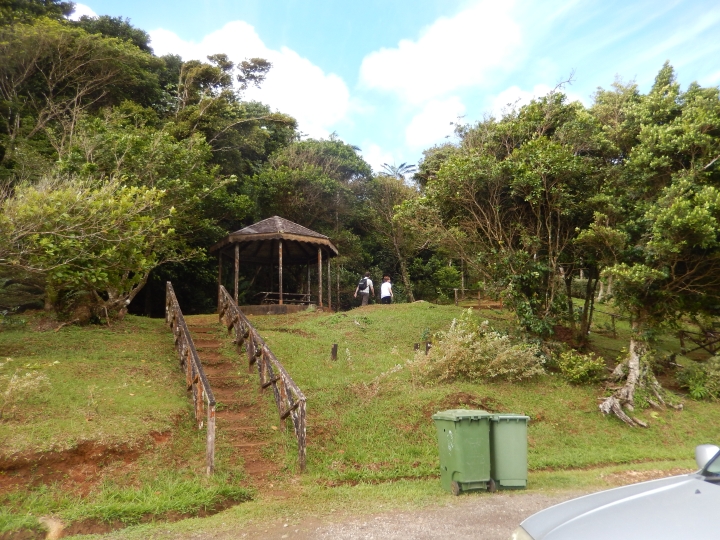
Two hikers set out on a 5 km trip, guided only by a cellphone
Should a father be afraid for their safety?
I was sure that, at the very least, someone would end the day with a broken bone, or six.
Nothing else to be done. They were determined and on their way. I started to drive back to De White House to wait for their call. Once home, I actually went online and posted to FaceBook the picture of my last sight of them intact, and with it, asked my wider community of friends and family for prayers.
Five hours later a text message came. “We are ready. Walking down Concord Falls Road. We’ll meet your car as you come up.”
I felt as though an enormous weight had been lifted from me. I jumped into my car and was on my way in seconds.
When I met them, they were exhilarated. Like little children. Talking, each one filling in the other’s sentences. How they found themselves on the edge of a cliff, slippery in rainforest wet. How sometimes they tromped calf-deep in mud. How Rachael fell into the mud. How spectacular the views were. How marvellous the waterfalls. They told me that going into the pool at the base of Concord Falls at least allowed them to clean off the mud.
Only later, back at the apartment, did they show me photos of themselves jumping off a very high cliff into that pool. At least they had done this under the guidance of a local boy, who makes money showing tourists at the falls (who drive up in busses) how it is done. Evidently the boy was so astonished that these two people had come across the mountain on their own, that he gave them special treatment.
Even when your children are all grown up, they can still make you go grey. Or at least grey-er.
A True Grenadian Moment
Monday, March 2, 2015
This morning we were out of eggs – and an egg breakfast is a must for me. As well, whenever he and Rachael visit, I always like to make and serve an egg breakfast for my son-in-law Michael. We couldn’t restock our eggs yesterday, because most grocery stores on the island are shut tight on Sundays, so I got up well before 8:00 AM this morning, made the coffee, then drove into Gouyave, on the assumption that the fairly well-supplied grocery store there would be open.
Negotiating traffic in the town’s narrow streets is a royal pain, and finding a place to park is even worse, so I simply parked on the edge of town by the seawall, and walked in.
There weren’t a lot of people about, which surprised me, and a number of the shops were still shuttered, but to my great relief the grocery store itself was open, and indeed had several shoppers inside, actively filling their baskets. Soon I had found everything that I needed.
Kaliko Shopping Centre in Gouyave is, to my Canadian eyes, little more than a hole in the wall – a one-room grocery store with about five aisles. But it is a modern enough business that I can pay by credit card – which I like to do, if only for the paper trail. There was a lady ahead of me at the cash register, however, who took absolutely ages to pay, because she had a plastic cannister full of coins, through which she was rummaging to find at least thirty Caribbean dollars. She put me in mind of the extreme poverty faced by some of the people here, where finding money for food is a major strain. I don’t know if this lady was truly impoverished – there was also something in her behaviour that suggested mental instability – but her cannister of coins would no doubt be similar to those held by the poorest of the poor, who’s only source of income might be begging, or the sale of a few vegetables at a roadside stand.
Eventually she was done counting out her coins, and my own purchases were quickly scanned, and bagged. I signed my credit card receipt and walked back to my car at the edge of town.
I had just turned it on, when a another car pulled up, and its driver, a total stranger, signalled me to roll down my window. I did so, and he offered a friendly “good morning.” Curious, I returned his greeting.
“You were just at the supermarket, I believe,” said the man, “and I was sent after you, because you left your credit card there.”
Ouch.
I thanked him profusely, then drove into the town (the very thing I had hoped to avoid). I had gone only a few metres when a bus driver leaned out his window and waved me down. As I have already described, busses here are actually just privately-operated minivans. They fly down the roads with as many as twenty passengers crammed into a space designed for nine. I supposed that this fellow just wanted me to move my car over slightly so that he could squeeze by me on the narrow street, but when I had passed his window, he motioned me to back up in order to speak to me. Whereupon a voice – or perhaps many voices – from within the packed bus said, “You left your credit card in the supermarket!”
I was probably beet red with embarrassment by this point, but I thanked them all, and proceeded to the store. Stopping in a “no parking” zone (behind a few other parked cars, I might add) I ran into the store, where several staff members greeted me warmly and handed me my card.
It seems as though the entire town was in an uproar because “de white man lef’ he card at de supermarket!” But all with one accord wanted to let me know that this was the case, and to make sure that I got it back.
Michael says: “If it had been some other islands I can think of, by the time you had walked to the edge of town, your card would have been sold to some cartel.”
It is, I conclude, a true Grenadian moment.
Grenada is a very nice place.
A Glimpse of Family Long Ago
Grenadians are truly kind, and very hospitable.
Early in this narrative I mentioned that at least part of our time in Grenada would be spent researching my ancestry. 1 My mother was born here, and her mother before her. In 2011, when our cruise ship stopped in Grenada for a day, I found the location of the house where Mom’s family was living when she was born 2 – I assumed, in fact, that the house was also her birthplace, since most babies were born at home in those days. Unfortunately, that house was destroyed by Hurricane Ivan in 2004, but the woman who had lived across the street for many years, very kindly gave me a photograph that she had of the place, as it had been before the hurricane. Grenadian kindness, again.
Grenadian kindnesses abound on this current trip. Whenever we are in conversation with someone and I mention my mother’s birth, we are showered with helpful tips and advice. People seem quite excited to learn that I have such a personal connection to their country. “Why, you are yourself a Grenadian!” they would exclaim.
“You mus’ go down to de government offices and see if they hab a record of you muddah’s birt’”
So I did that. I located the Office of Births and Deaths in the government complex in St. George’s, went in and found myself in front of a glass-fronted wicket. “I’m wondering if I can get proof of my mother’s birth?” I said to the young lady who who had risen from her desk to came to the wicket.
“What information do you have?” she asked, and proceeded to write as I told her my mother’s name, her date of birth, my grandparents’ names, and the probable location of the birth, in a house called, “Observatory.” Then she went back to her desk and opened a page on her computer. She clicked, and peered, and clicked some more... until I began to become quite worried that nothing would be found.
Then she lit up. “I found something!” she said.
In fact she soon became certain that she had found the exact record, so now what I must do is pay the treasury a small fee, and after I had shown her the treasury receipt, I could return in a few days and an official certificate of my mother’s birth in Grenada would be mine.
Following her instructions, I walked across to another building – the one marked “Treasury” – and waited in line at another wicket. When my turn came, I gave them seven Caribbean dollars, and the small square of paper that the woman in “Births and Deaths” had given me. Soon I had a receipt covered in official stamps, which I carried back up to the Office of Births and Deaths. The woman noted the receipt’s number in her records, and told me to come back on Tuesday.
Which I did. And was shown a long, very formal, and mostly hand-written extract from the registry of births and deaths. The woman affixed a paper stamp to it, sealed it with an embossed government seal, and handed it to me.
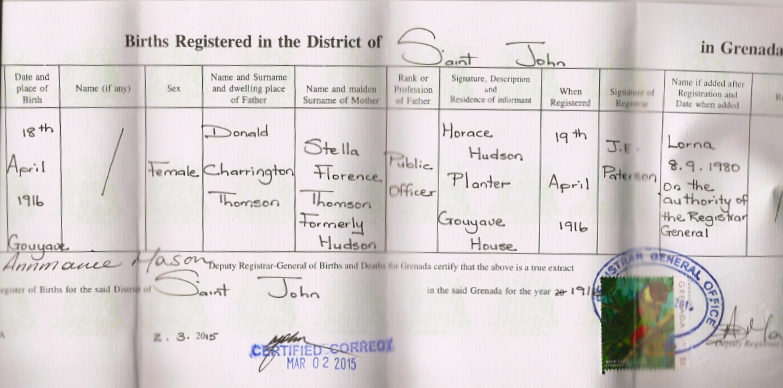 My Mother’s Birth Certificate The certificate itself is so long, it overflows the scanner |
There was Mom’s date of birth; there was my grandfather’s full names (I had not known his middle name prior to this); his occupation as “Public Officer;” and my grandmother’s full names.
There was also a mystery: my mother’s given name was listed as being entered into the register in 1980! What? She was born in 1916!!!
I can only suppose that the baby had not yet been named when her birth was registered, and that her given name was correlated with the file much later – perhaps by means of a Baptism record – when old records were first being entered into a computer database.
There was also a big surprise for me: Mom’s place of birth was not the house called “Observatory,” as I had supposed; no, she was born in Gouyave. And the person who registered her birth was her grandfather, listed on this document as, “Horace Hudson, Planter, of Gouyave House.”
I have therefore fabricated the following narrative: at the time my grandmother became pregnant, she was living in the very fine house on Observatory Road, in the capital – as the wife of a government official. But, when her due date drew near, she decided to travel the twenty kilometres up island to the town of Gouyave, to her own father’s home, where she could have the baby, surrounded by family and loving servants – some of whom had probably known her since she was born.
So my mother was born in Gouyave, in the great plantation house of her grandfather, who – since men were pretty useless around childbirth – made it his business to go down to the local government office to register the birth.
I have known all my life that Horace Hudson – my great-grandfather – was a “planter.” He either owned a large plantation in Gouyave, or else he operated it in behalf of overseas owners. What I didn’t know was where his plantation house might be. Attending St. John’s church partly helped sort out this mystery, and partly it did not, for some of the oldest parishioners thought the house might be this place, while others supposed it was that place.
Then came the parish barbecue.
Loretto
At the end of the Sunday service, at announcement time, the lay reader announced, “Next Friday will be the barbecue, our annual fundraiser. Tickets are available at the back of the church.”
We thought that it might be nice to attend a barbecue, visit with some people, make friends, and possibly pick up a tip or two about my forebears. We bought four tickets: for me, Heather, Werner and Mary.
When the day came we showed up at the church hall to find three or four professional barbecues sizzling away with fish and chicken and pork. Several ladies were ladling food into styrofoam containers.
But where were all the people?
The four of us stood around looking a bit bewildered. Eventually I asked one of the busy ladies, who said, “Oh dear! Nobody comes to our barbecues! After all, most people work during the day. We prepare the food and deliver it to their workplaces.”
Oh. So much for our attempt to be friendly and mix in.
So, deciding instead to be helpful, I said, “I have a car. Perhaps I can make one of the deliveries for you?”
“That would be splended!” said the chief organizer. “We had no one to go up to the Florida School, and it is much too far to walk. Here: Mrs Rogers has the food order, she will go with you and direct you up to the school.”
In due course, Norma Rogers (she allowed me to use her given name, since Canadians all seem to like to do that) was directing me along St. Peter’s road, up into the hills behind the town, higher and higher, until, turning into a narrow lane, we emerged onto a parking lot beside some low school buildings, and the largest, grandest Nineteenth Century mansion I had yet seen on the island. Hundreds of tiny children in yellow shirts and dark skirts or trousers were rushing about and shouting, and carrying cricket things and generally behaving like healthy and enthusiastic children on recess.
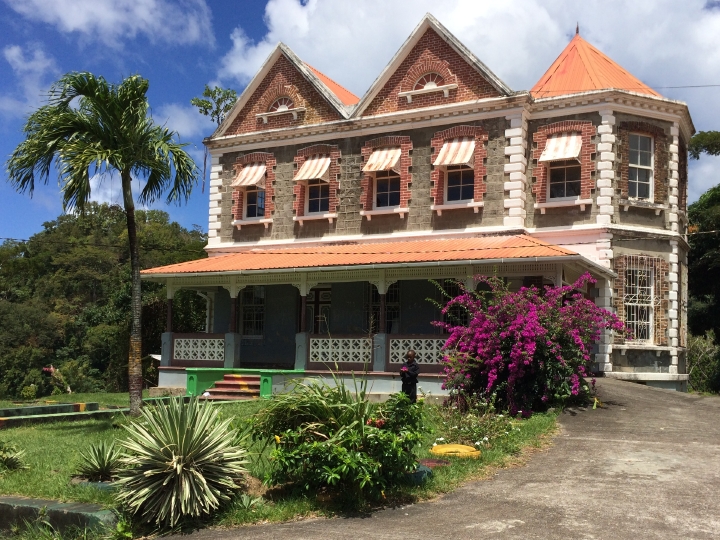
A beautifully-preserved 19thC plantation house
However, Mrs. Rogers’ lunch delivery was not for the children, but for the staff. She went into the school and eventually came out with someone who looked like the principal, who murmured her thanks to me as Norma got into the car.
On the way back to the church, I asked Norma if she knew the story of the fine building that comprises the main structure of the school. She did not – explaining that she was born and raised in Westerhall, on the other side of the island, and only married a Gouyave man, so she didn’t know much of the local history.
I wondered if it might be the Gouyave Estate house. She said that Janet Butler, back at the church, would know.
Soon I met Janet Butler, who did know, and said that the house was indeed an estate house, and was once called “Loretto.”
Well, this was gold. Although it may not have been the plantation house where my mother’s forebears lived, its name has been in family lore all my life. It was a place that they often visited for social occasions and parties and such like. I believe that we have antique pictures of family gatherings on the lawns of “Loretto.”
Meanwhile, although the barbecue continued as a delivery service, the people of the parish were so concerned for their Canadian visitors that by the time Norma and I had returned from Loretto, they had laid a white tablecloth, and called Fr. Ballantyne. The Rector then sat down at this table, with me, Heather, Werner and Mary; as did Norma Rogers, as did the parish’s oldest parishioner, Gladys Simmons (91) – and we all proceeded to have an elegant barbecue meal!
Gladys Simmons actually remembers hearing the name “Horace Hudson” in conversation when she was a girl.
Hospitable Grenadians.
Finding Aunt Ethel
Long ago, in 1972, I was working in the Caribbean, and I managed to visit Grenada. I came to Gouyave and found my grandmother’s last living sister: Ethel McIntyre, who lived in a large house at the top of a straight street in Gouyave. Her upstairs porch, where she lived, had a spectacular view of the town and the jetty and the sea. I sat there with her, chatting, enjoying the view, and enjoying getting to know this woman who was so very much like my beloved grandmother.
In 2015 Aunt Ethel would be about a hundred and thirty years old, so I didn’t expect to find her alive, but there should be a grave somewhere, shouldn’t there? I found several McIntyre graves in the St. John’s churchyard, but Eveline McIntyre – who I think would be Ethel’s great-niece – didn’t appear to know if any of them were Ethel’s.
Then, discussions with various other church members gave us a new idea.
I tend to forget that my mother was not born Anglican. During World War Two, she and my father were converted from being secular humanists, to being Anglican, a form of Christianity that neither had known in their youth.
“Would my Aunt Ethel be buried in this churchyard if she was, for example, a Methodist?”
“Oh no,” said a number of voices. “If she was not a member here, she would likely be buried in the government graveyard down Douglaston Road!”
Ahhhh...
On our last day, we went to the Douglaston cemetery. A bunch of fishermen were relaxing in the shelter there, after a heavy morning with their nets, and were quite interested in this old couple who had parked their car and come into the graveyard.
“You people looking for a partic’lar tomb?” one of them called out.
“Yeah,” I replied, “McIntyre.”
“They be a ‘McIntyre’ tomb right here!” he said, jumping up and guiding me down to a spot only metres away.
And there she was! Along with her husband, Donald! A fine tomb, with a low steel railing, and a marble marker bearing their names and dates, all looking rather the worse for wear in the 38 years since the tomb was erected. The Caribbean climate is not easy on human artifacts.
Ethel died in 1977, it seems, the year before Maurice Bishop seized power and began inviting Cubans to build a high-speed airport. Her husband, Donald, had died in 1969. They never knew their country’s tumultous years.
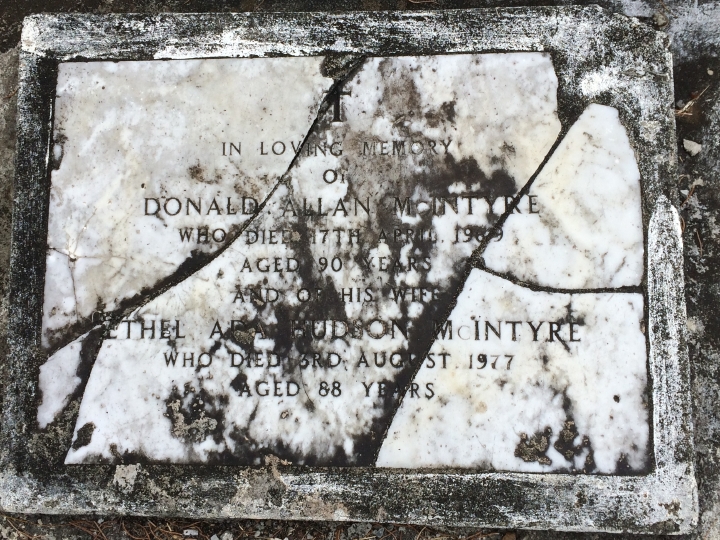
Grave marker for my great-aunt and her husband “Donald Allan McIntyre, who died 17th April 1969, aged 90 years” “Ethel Ada Hudson McIntyre, who died 3rd August 1977, aged 88 years” |
Next: Blessings
FOOTNOTES:
1 See “Why Grenada?” in Part 1 of this Living in Grenada diary.
Click here to get back to the narrative.
2 See “The search for family roots,” in our 2011 Caribbean Cruise diary.
Click here to get back to the narrative.
